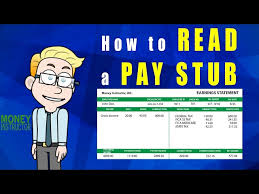How to Read a Pay Stub (2025 Step-by-Step Guide)
Introduction: How to Read a Pay Stub
Learning how to read a pay stub is essential for every employee who wants to understand where their hard-earned money goes. Your pay stub provides a detailed record of your earnings, taxes, and deductions for each pay period. By understanding each part of your paycheck, you can verify accuracy, catch mistakes, and make smarter financial decisions. Whether you are a new hire or an experienced worker, this guide will help you clearly understand every element on your stub. You can also explore our Deductions on a Pay Stub guide for deeper insights.
What Is a Pay Stub and Why You Should Read It
Before learning how to read a pay stub in detail, it helps to understand what it represents. A pay stub—also known as a paycheck stub or wage statement—is a document provided by your employer that shows how your gross pay is reduced by various deductions to result in your net pay. It also includes your employer’s details, tax information, and contributions to benefits such as insurance or retirement. Reviewing your pay stub regularly ensures you are paid correctly and that all deductions are legitimate. You can also generate one online using a trusted tool like the Pay Stub Generator.
Step-by-Step Guide on How to Read a Pay Stub
1) Employee and Employer Information
When you start to learn how to read a pay stub, begin with your personal details. Ensure your name, address, and employee ID are correct. Check your employer’s name and company address for accuracy too, as this helps with recordkeeping and future employment verification.
2) Pay Period and Pay Date
The pay period shows the specific time frame your wages cover. The pay date tells you when that payment is issued. Comparing these helps confirm your hours and earnings match what you actually worked.
3) Earnings Section
This section lists your gross pay before any deductions. You might see regular wages, overtime pay, and bonuses. Always check that your hourly rate and total hours are accurate. For comparison, visit our Free Pay Stub Template to see how this section looks in an example layout.
4) Deductions Section
Understanding deductions is key when learning how to read a pay stub. These include federal and state taxes, Social Security (FICA), Medicare, health insurance, and retirement contributions. Each deduction should be clearly labeled so you can track where your money goes.
5) Net Pay
Net pay, also called “take-home pay,” is the amount you receive after all deductions are made. This is the figure deposited into your account or printed on your paycheck. Knowing how to read a pay stub ensures this amount matches your expectations based on your salary or hourly rate.
Why Knowing How to Read a Pay Stub Matters
When you know how to read a pay stub, you gain control over your finances. You can detect payroll errors, confirm benefit contributions, and manage your taxes efficiently. Keeping copies of your pay stubs also helps when applying for loans, renting apartments, or filing taxes. If you want to create your own professional stubs, try the Regular Pay Stub generator for accuracy and compliance.
Conclusion: Mastering How to Read a Pay Stub
Now that you understand how to read a pay stub, reviewing your paycheck will no longer be confusing. Always check the gross pay, deductions, and net pay to make sure everything aligns. Store your pay stubs safely and review YTD totals regularly. To continue learning, explore our related resources such as Pay Stub Abbreviations Guide and How to Create a Pay Stub. You can also generate professional documents using the Pay Stub Generator for instant results.

